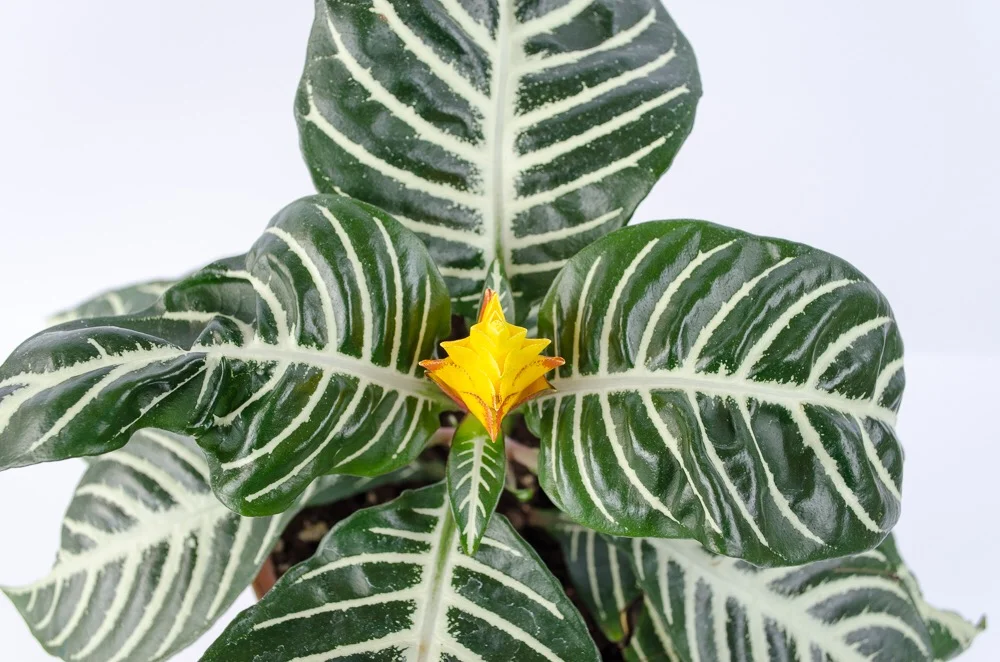Plant profiles: Aphelandra squarrosa (zebra plant)
A classic houseplant, the Aphelandra squarrosa (aka zebra plant or saffron spike) is quite popular at the moment and is being sold at most big box hardware stores and little nurseries alike. I've spotted them at Lowe's for months now and finally decided to take one home with me! These are high-maintenance plants and I'm going to be real with you: they're not the best choice for beginner green thumbs. However, with a little extra TLC and attention, your zebra plant will thrive!
Aphelandra squarrosa is native to Brazil and has dark glossy green leaves that can grow up to 9 inches long, with deep silvery-white veining. The foliage alone is striking, but the plant also features interesting column-like bract flowers, making this a houseplant that does double duty! Flowers are typically a golden yellow, but can also be orange depending on the variety of zebra plant.
Lighting: During most of the year, the zebra plant will flourish in bright indirect light; don't allow too much hot, direct sun on the foliage, however, or the leaves will crinkle. This plant will do really well on a shady porch in the summer, soaking up the indirect light and extra humidity. In the winter, a zebra plant can handle more moderate light.
Watering: Potting soil must be kept moist at all times, but not soggy, which is one factor in this plant's temperamental upkeep. If the soil is left dry for too long, the leaves will drop and the plant will be leggy. The zebra plant also prefers tepid, soft water. Leave some water out until it reaches room temperature before drenching the soil thoroughly. Leaving water out for 24-48 hours also helps dissipate some of the chemicals in hard tap water!
Humidity + temp: Keep the plant in average household temperatures, but don't let it stay in temperatures below 55°F. The zebra plant also requires as much humidity as you can possibly give it and humidity shouldn't drop much below 60%. A pebble tray combined with grouping the plant with other plants works well to increase ambient humidity. You can also place moist spaghum moss on top of the soil, or stuff it in a cache pot if you're using one. Extra humidity is created as the moss dries and the water evaporates!
Soil + fertilizer: Zebra plants do well in a peat-based potting soil that has adequate drainage, but retains moisture at the same time. Try a 50/50 mix of standard potting soil and African Violet soil! During growing season, you can feed your plant with a balanced fertilizer every 2 weeks if you want and reduce feeding to once a month or less in the winter since growth will slow down.
Repotting: Zebra plants will rarely need a pot bigger than 6” in diameter since the plant itself typically doesn’t grow to be more than 15” tall and they don't mind being rootbound. That said, you can still repot each spring to refresh the soil.
Pruning + upkeep: Flowers will usually appear sometime after summer and last about 6 weeks, which is longer than most flowers on tropical plants that are grown more for their foliage. After the flower starts to die off, clip it and allow the plant to rest for a couple of months. During this time, place it in more moderate light and water less.
Common problems:
- Leaf drop - the most common cause of leaf drop is that the soil is too dry. Other possibilities include too much cold air or cold drafts.
- Brown leaf tips - Humidity is too low. See my post on ways to increase humidity here.
- Crinkly or puckered leaves - the plant is getting too much direct sun.
Fun fact: Zebra plants are non-toxic to pets!
The zebra plant is also referred to as a "saffron spike" due to it's unique golden-yellow blooms.


